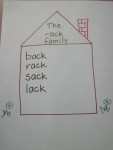It seems like if my child doesn’t already know their colors and shapes by the first day of school they will be behind. Is this true?
Nowadays identifying shapes and colors is something that while not required for entry into Kindergarten it is pretty much expected. Number identification, addition, subtraction, counting to 100, patterning, measurement, and graphing are just a few of the concepts your child will learn this year, and having some prior knowledge about shapes and colors will make learning these concepts a lot easier. Below are the curriculum guidelines for shapes (in Texas). Curriculum guidelines for color don’t even exist. Of course there are many opportunities for students to use color in mathematics, patterning, comparisons, and identifying attributes.
8(C) sort a variety of objects including two- and three-dimensional geometric figures according to their attributes and describe how the objects are sorted
9(A) describe and compare the attributes of real-life objects such as balls, boxes, cans, and cones or models of three-dimensional geometric figures;
9(B) recognize shapes in real-life three-dimensional geometric figures or models of three-dimensional geometric figures; and
9(C) describe, identify, and compare circles, triangles, rectangles, and squares (a special type of rectangle).
While shape identification is most certainly a part of the math curriculum, you see that students will also have to describe and compare three-dimensional shapes in both the real world and with models. This means that any bit of prior knowledge you can give your child concerning shapes will help them with the geometry and spatial reasoning portion of their math.
Know that I know, what can I do?
Shape Walk: Go on a shape walk. Take a walk and point out all the shapes of different objects you see. If you like, take pictures of the objects/shapes you find on your walk. Then print these out and make them into a book.
Color Race: Quirky Momma has a cute idea for a Color Race. Before starting announce the color that you will be looking for during the race. Then turn on some music and have your child collect as many items of that color as they can before the song is over. Then put the items back and pick a new color.
Rainbow Writing; Have your child write their name in all the colors of the rainbow. Be sure to discuss each color as they write.
Read Color Books: Brown Bear, Brown Bear What Do You See?, Color Zoo, Little Blue and Little Yellow, A Color of His Own and My Many Colored Days are just a few. Of course you can also just talk about the different colors you see as you read any book.
Sort odds and ends: Gather odds and ends from around the house. Anything will work and then sort them by color, shape or both. Be sure to discuss the different shapes and colors you sort by.
I Spy: Play I Spy the regular way with colors but also change it up and spy different shapes!
Puzzles and Board Games: Look for puzzles or board games that teach shapes and colors. Candyland is an old favorite! Plus these can also teach counting, spatial reasoning, numbers, sequencing and other math concepts, an added bonus!
Feely Bag: Place different objects in a bag. Have your child just feel the object to see if they can determine the shape.






